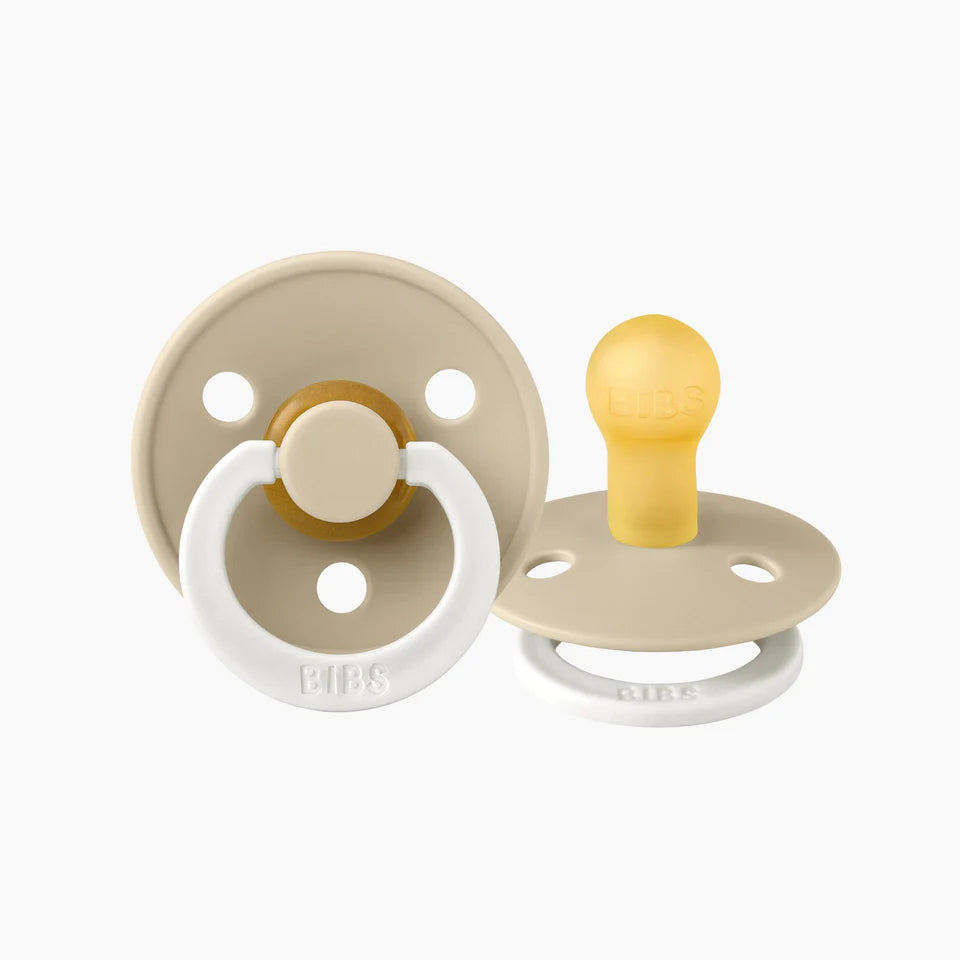BIBS
BIBS Dummies Twin Pack - GLOW
Couldn't load pickup availability
BIBS Colour GLOW has the same high quality as the original BIBS pacifiers but has a practical glow feature.
The glow feature makes it easy for both parents and little ones to find the pacifiers in the dark and accommodates the frustration it can cause for parents to stand in the middle of the night - in total darkness - looking for the pacifier with a crying child. Simply hold the pacifier up to a lamp for 5-10 sec. to activate the effect. The luminescent effect lasts for 8+ hours.
- Glows in the dark
- Available in natural rubber latex
- The shield is made of 100% safe food-grade material
- Designed and manufactured in Denmark/EU
Read more about the GLOW pacifiers here >>
Nipple information: The nipple is equipped with a valve that lets out air when the baby closes down on the nipple thereby flattening the nipple to shape naturally after the baby's oral cavity.
Read the full nipple guide here >> The nipple is produced from natural rubber latex. Since natural rubber latex is a natural material, color variation may occur. Read more about sustainable rubber latex here >>
Shield information: The round lightweight shield faces away from the sensitive and delicate skin around the baby's mouth to ensure minimum contact with the baby's nose and mouth, which means less chance of moisture build-up from saliva that can cause rashes and sore spots. The shield comes in one size no matter the nipple size. The shield is made of 100% safe food-grade PP.
Size information: Available in sizes 1, 2, and 3 (natural rubber latex). It is important to inform you that our different sizes are only a guide for you to follow. Our experience is that the following sizes are the general and therefore also our common recommendation.
Size 1: 0+ months
Size 2: 6+ months
Size 3: 18+ months
Sterilization by scolding
This is the method we recommend for cleaning both latex and silicone pacifiers subsequently:
- Put the pacifiers in a clean bowl. Pour boiling water over the pacifiers.
- Let the pacifiers soak for approx. 5 min.
- Pick them up and let them dry on a clean towel.
This method is gentle, but still gets rid of bacteria without compromising the durability of the pacifier. We only recommend boiling the pacifiers before the first use - not subsequent cleaning. Pacifiers are not meant to be boiled repeatedly and can be destroyed by continual exposure to high heat. Instead, follow the instructions above.
Sterilization by microwave sterilization
Be aware that latex will break down if the temperature exceeds 100°C / 212°F. Therefore, we do not recommend microwave sterilization of natural rubber latex.
Silicone endures higher temperatures than latex. Therefore, you can use microwave sterilization for silicone pacifiers. However, make sure that the temperature does not exceed 110°C / 230°F. The pacifier shield is made of PP, which will break if temperatures exceed 110°C / 230°F. Also, repeatedly exposing pacifiers to temperatures above 100°C can be harsh on them, and it will shorten their durability and lifespan over time.
Therefore, our general recommendations are that to use microwave sterilizations you must check the manufacturer’s instructions to make sure the temperature stays around 100°C / 212°F. In most microwaves, this means that the pacifiers must be heated for a maximum of 60 seconds at max. 800W. Always remember to put the pacifiers in water in a sterilization box made for the purpose. Never place the pacifiers in the microwave without!
Read our blog post on how to microwave sterilize silicone pacifiers in our BIBS pacifier Box >
Sterilization by electric steam sterilizing devices
Be aware that latex will break down if the temperature exceeds 100°C / 212°F. Therefore, we do not recommend using steam sterilizer devices for natural rubber latex pacifiers.
Silicone endures higher temperatures than latex. Therefore, you can use electric steam sterilizing devices for silicone pacifiers. However, make sure that the temperature does not exceed 110°C. The pacifier shield is made of PP, which will break if temperatures exceed 110°C / 212°F. And like with microwave sterilization, exposing the pacifiers repeatedly to temperatures above 100°C can be harsh on pacifiers. Therefore, our general recommendations are that to use steam sterilizer devices you must check the manufacturer’s instructions to make sure the temperature stays around 100°C / 212°F.
Sterilization by UV sterilizing devices
We do not recommend using UV sterilizing devices for either natural rubber latex or silicone pacifiers.
Natural rubber latex is a natural material that undergoes a natural aging process, that can be influenced by external forces such as UV light. Therefore, never use a UV sterilizer for our latex pacifiers as it will damage the material. Also never leave natural rubber latex in direct sunlight.
Further, UV light only kills germs if it directly shines on the product surface containing bacteria, unlike steam which is a gas and can easily spread across the entire surface of a pacifier regardless of shape. Therefore, we do not recommend using a UV sterilizer for any of our pacifiers.
Sterilization by using sterilizing solutions
We do not recommend using the sterilizing solution for either natural rubber latex or silicone pacifiers, as the solution can damage the material if the pacifier is left in for longer than recommended.
Sterilization by dishwasher cleaning
We do not recommend cleaning either latex or silicone pacifiers in a dishwasher. The cleaning agents can damage the material (both latex and silicone) and it can become brittle. Furthermore, most dishwashers do not reach temperatures high enough to sufficiently sterilize the pacifiers.
If you experience water in the nipple
After cleaning it is not unusual that water remains in the nipple. This is because all our pacifier nipples are equipped with a valve, letting out air when the baby closes down on the nipple. This ventilation system causes the air from inside the nipple to be pushed out through the valve thereby flattening the nipple to shape naturally after the baby's oral cavity. The valve is also the reason why water can be present inside the nipple after cleaning and sterilization. If this is the case, simply just squeeze the nipple flat to press out the excess water. If water drops remain in the nipple, just let the pacifier air-dry.
How often should I clean the pacifiers?
Part of good pacifier hygiene is frequent cleaning of the pacifiers. The younger the child, the more important it is to protect it from bacteria and maintain good pacifier hygiene. This is mainly because small children’s immune system has not yet managed to get acquainted with all the different bacteria, and therefore it will not have learned to “defend” against them yet.
You should sterilize your baby’s pacifiers regularly, but don’t overdo it. Sterilization can be harsh on pacifiers, depending on the method Our general recommendation is to scald the pacifiers once a day.






